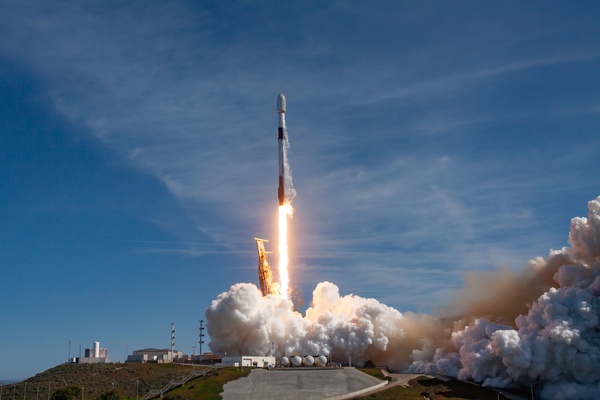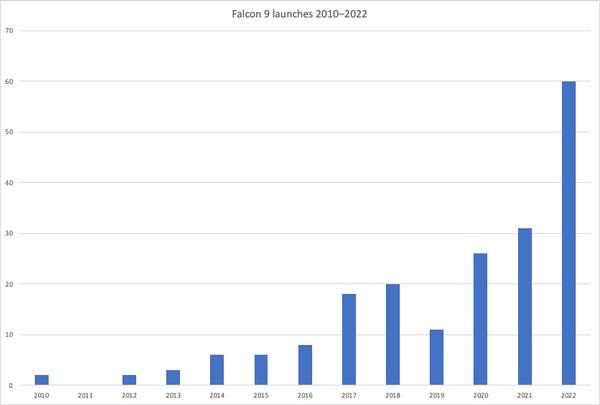 A Falcon 9 lifts of on its most recent launch March 3. SpaceX has already performed 15 launches this year as it seeks to fly up to 100 times in 2023. (credit: SpaceX) |
The Falcon 9 achieves the shuttle’s dreams
by Francis Castanos
Monday, March 6, 2023
One fascinating way of looking at Falcon 9 is to compare it to the late Space Shuttle. While completely different from a technical standpoint, they nonetheless have three basic objectives in common:
- partially reusable: check
- places up to 23 tons into orbit: check
- launches once a week: check.
The last point is worth closer examination.
Fly a lot and prosper
In 2022, the Falcon family (Falcon 9 and Falcon Heavy) flew 61 times; all but one were of the Falcon 9. This is a remarkable number for many reasons, if only because of a forgotten number related to the Space Shuttle: the 1969–1972 dreamed vehicle, not the controversial one we got in 1981 to 2011.
A baseline mission model developed by The Aerospace Corporation projected 736 launches from 1978 through 1990, or about 57 launches per year. While nobody noticed, last year the Falcon 9 has exceeded the long-forgotten shuttle projected flight rate.
The shuttle, of course, never achieved a flight rate of 57 launches per year. Instead, the progression of launches looked like this:
- 57 flights per year: a 6.4-day turnaround.
- 52 flights per year: a 7-day turnaround (once a week)
- 36 flights per year: a 10-day turnaround: often quoted in NASA 1970s documents.
- 24 flights a year: that was the (1988) objective, fixed somewhere in the late 1970s.
- 11 flights in a year: the real world record of 1985–1986, and we all know how it ended (shudders).
- 8 flights in a year: that’s 1996 for you. The post-Challenger record.
| It is fascinating to realize that, in 2022, Falcon 9 achieved the shuttle’s early objectives at last. |
With perfect hindsight 1996 seems to be the closest we ever got from a reasonable, realistic Space Shuttle annual flight rate. Remember: the fleet was back to four orbiters since 1992: Columbia, Discovery, Atlantis, and Endeavour. For the record, 1996 was also the beginning of a new and dangerous era that drove the shuttle into the wall for the second time: STS-107. The CAIB clearly identified severe budget cuts of the late Goldin era as a major driving force there. Faster-better-cheaper may have been useful early on, but they pushed it way too far. The 1999 Great Mars Fiasco was an early warning through the robotic exploration program. STS-107 was its counterpart in the human spaceflight area, unfortunately.
Now, how do Falcon 9 flight rates compare to the above? Falcon 9 started flying in June 2010 and has now flown more than 200 times. What can be said about it, though, compared to Space Shuttle own flight rates?
 |
Falcon 9 flight rates reached a first plateau in the 2010s that put them in line with the shuttle’s highest flight rates. It took Falcon 9 until 2020, though, to get itself out of that plateau. In 2020 and 2021 the flight rate jumped significantly. The reason is all too obvious: Starlink.
Conclusion
And so, by 2022 there it is: the Falcon 9 flight rate exceeded NASA’s early 1970s projections of one shuttle launch every 6.4 days. And it will not stop there. SpaceX’s next objective is 100 flights a year. (As of early March SpaceX had conducted 14 Falcon 9 launches and one Falcon Heavy.)
As noted in the introduction, it is pretty interesting to try and compare Falcon 9/Dragon and Space Shuttle. They are both partially reusable with a crewed capability and/or 23 tons to orbit payload, not to mention the goal of flying once a week to support a space station.
But beyond that, they are utterly and absolutely different. Still, as a space nerd who grew up in the 1990s it is fascinating to realize that, in 2022, Falcon 9 achieved the shuttle’s early objectives at last!
Note: we are using a new commenting system, which may require you to create a new account.
No comments:
Post a Comment